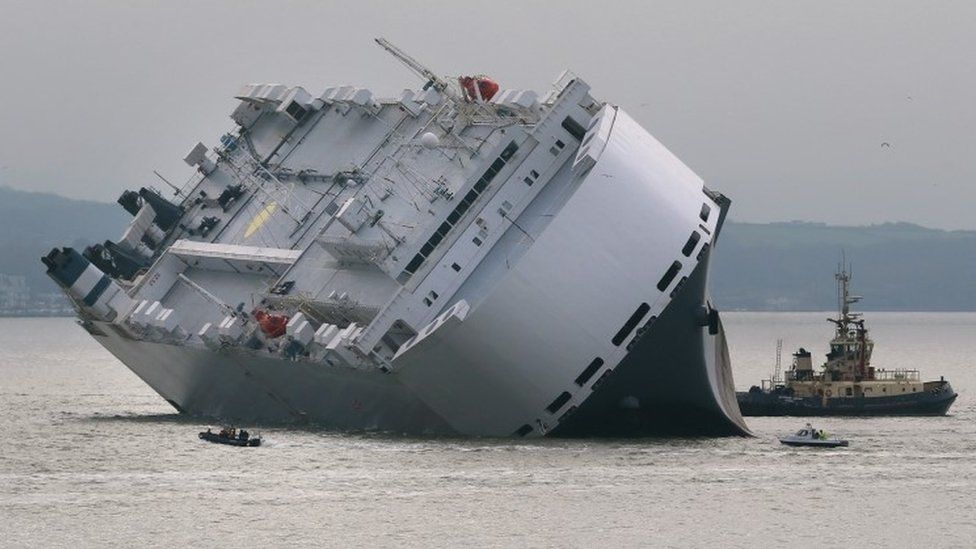Hoegh Osaka ship was 'unstable' when it left Southampton port
- Published

The Hoegh Osaka spent 19 days stranded in the Solent
A cargo ship which became stranded in the Solent for 19 days after developing a severe list was "unstable" when it left port, a report says.
The Hoegh Osaka ran aground in January 2015 on its way from Southampton to Bremerhaven carrying high-end cars.
A "significant difference" between the actual and estimated cargo weight left it unstable and contributed to the accident, marine investigators found.
Owner Hoegh Autoliners said no one person could be blamed for the error.
"There were a number of circumstances here. We cannot put responsibility on one individual or group," a spokesman for the shipping company said.
The 51,000-tonne vessel, which left Southampton on 3 January 2015 at 20:06 GMT, was "rounding West Bramble buoy in the Solent when it developed a significant starboard list, causing some cargo shift and consequent flooding", the Marine Accident Investigation Branch (MAIB) report, external said.
Hoegh Osaka
51,770
gross tonnage
180
metres long
-
2000 Year ship was built in Japan
-
1,450 Cars on board
-
5,814 Tonnes of cargo
The pilot gave the order to "stop engines" at 21:10 GMT and the ship continued to list at an angle of 40 degrees, leaving the rudder and propeller out of the water.
A JCB stone cutter broke free of its lashings and ripped a hole in the hull, causing sea water to enter the ship.
One off-duty crew member broke an arm and a leg as he stumbled and fell 18m down a corridor, hitting the door at the end.
MAIB chief inspector Steve Clinch said: "The MAIB's investigation found that Hoegh Osaka's stability did not meet the minimum international requirements for ships proceeding to sea.
"Crucially, the assumed distribution of ballast on board bore no resemblance to reality, which resulted in the ship leaving Southampton with a higher centre of gravity than normal."
The report, external concluded:
Hoegh Osaka's actual cargo weight and stowage were significantly different to the final cargo tally supplied to the ship
Hoegh Osaka's chief officer believed he knew with sufficient accuracy the quantity of ballast water in each tank. To comply with the Wallem SMS [safety management system] requirement for ballast tank soundings to be recorded daily, the chief officer falsified the sounding records
Witness and anecdotal evidence suggests that the practice of not calculating the actual stability condition on completion of cargo operations but before the ship sails extends to the PCC/PCTC [pure car carrier/pure car and truck carrier] sector in general
Salvors found that 27% of the cargo had been damaged
The heavy cargo included JCB equipment, Land Rovers and other cars
Land Rovers were estimated to be two tonnes each but actually weighed significantly more, which accounted for almost 350 extra tonnes.
The report said: "Cargo distribution was such that the upper vehicle decks were full while the lower vehicle decks were lightly loaded.
"The ship's inadequate stability had not been identified as no accurate stability calculation had been carried out before the ship sailed."
It also said no stability estimation had been completed after all the cargo had been loaded, which had "become the norm" in the car carrier sector in general.
Analysis
by Paul Clifton, Transport correspondent, BBC South
There's a very telling sentence in the report: "Unsafe practices had become the norm."
The faults which led to the most dramatic incident in the Solent in decades are not confined to this ship, this company or this port.
They are, the report suggests, endemic throughout the car carrying industry.
When it happened, there were hints that only the brave actions of the captain and pilot had led to the ship being grounded on Bramble Bank.
Today's report says no such thing. It was pure chance that the ship ran aground in shallow water.
If the ship had started to turn a few moments earlier or later, the Hoegh Osaka would have ended up in the only deep water channel.
It would have stopped the container port, stopped the cruise ships, stopped the ferries. And it would have meant Britain's largest oil refinery running out of supplies.
The MAIB recommended Hoegh Autoliners "enhance its internal procedures and instructions to ensure that the stability of its vessels is maintained throughout the operating cycle".
The report said the ship owners had commenced an internal investigation and introduced new procedures.
The rudder and propeller ended up out of the water
- Published17 March 2016
- Published11 February 2015
- Published27 January 2015
- Published22 January 2015
- Published21 January 2015
- Published19 January 2015
- Published4 January 2015